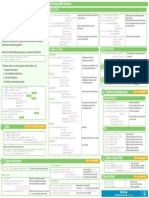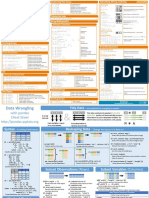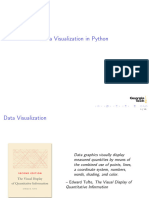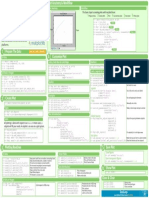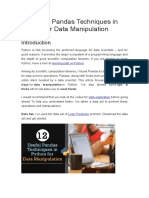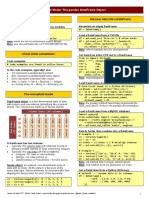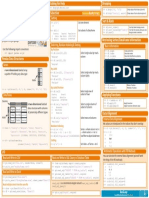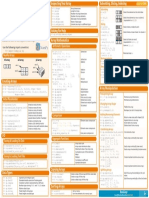100%(1)100% found this document useful (1 vote)
482 viewsNumpy Python Cheat Sheet
The document provides a summary of key NumPy functions for inspecting, subsetting, slicing, indexing, and performing arithmetic operations on multidimensional arrays. It explains how to import NumPy, create arrays of different dimensions, get array properties like shape, size, and data type, select subsets of elements, and perform element-wise mathematical operations like addition, subtraction, multiplication, and division.
Uploaded by
Josh IzCopyright
© © All Rights Reserved
We take content rights seriously. If you suspect this is your content, claim it here.
Available Formats
Download as PDF, TXT or read online on Scribd
100%(1)100% found this document useful (1 vote)
482 viewsNumpy Python Cheat Sheet
The document provides a summary of key NumPy functions for inspecting, subsetting, slicing, indexing, and performing arithmetic operations on multidimensional arrays. It explains how to import NumPy, create arrays of different dimensions, get array properties like shape, size, and data type, select subsets of elements, and perform element-wise mathematical operations like addition, subtraction, multiplication, and division.
Uploaded by
Josh IzCopyright
© © All Rights Reserved
We take content rights seriously. If you suspect this is your content, claim it here.
Available Formats
Download as PDF, TXT or read online on Scribd
You are on page 1/ 1
Python For Data Science Cheat Sheet Inspecting Your Array Subsetting, Slicing, Indexing Also see Lists
>>> a.shape Array dimensions Subsetting
NumPy Basics >>>
>>>
len(a)
b.ndim
Length of array
Number of array dimensions
>>> a[2]
3
1 2 3 Select the element at the 2nd index
Learn Python for Data Science Interactively at www.DataCamp.com >>> e.size Number of array elements >>> b[1,2] 1.5 2 3 Select the element at row 1 column 2
>>> b.dtype Data type of array elements 6.0 4 5 6 (equivalent to b[1][2])
>>> b.dtype.name Name of data type
>>> b.astype(int) Convert an array to a different type Slicing
NumPy >>> a[0:2]
array([1, 2])
1 2 3 Select items at index 0 and 1
2
The NumPy library is the core library for scientific computing in Asking For Help >>> b[0:2,1] 1.5 2 3 Select items at rows 0 and 1 in column 1
>>> np.info(np.ndarray.dtype) array([ 2., 5.]) 4 5 6
Python. It provides a high-performance multidimensional array
Array Mathematics
1.5 2 3
>>> b[:1] Select all items at row 0
object, and tools for working with these arrays. array([[1.5, 2., 3.]]) 4 5 6 (equivalent to b[0:1, :])
Arithmetic Operations >>> c[1,...] Same as [1,:,:]
Use the following import convention: array([[[ 3., 2., 1.],
>>> import numpy as np [ 4., 5., 6.]]])
>>> g = a - b Subtraction
array([[-0.5, 0. , 0. ], >>> a[ : :-1] Reversed array a
NumPy Arrays [-3. , -3. , -3. ]])
array([3, 2, 1])
>>> np.subtract(a,b) Boolean Indexing
1D array 2D array 3D array Subtraction
>>> a[a<2] Select elements from a less than 2
>>> b + a Addition 1 2 3
array([[ 2.5, 4. , 6. ], array([1])
axis 1 axis 2
1 2 3 axis 1 [ 5. , 7. , 9. ]]) Fancy Indexing
1.5 2 3 >>> np.add(b,a) Addition >>> b[[1, 0, 1, 0],[0, 1, 2, 0]] Select elements (1,0),(0,1),(1,2) and (0,0)
axis 0 axis 0 array([ 4. , 2. , 6. , 1.5])
4 5 6 >>> a / b Division
array([[ 0.66666667, 1. , 1. ], >>> b[[1, 0, 1, 0]][:,[0,1,2,0]] Select a subset of the matrix’s rows
[ 0.25 , 0.4 , 0.5 ]]) array([[ 4. ,5. , 6. , 4. ], and columns
>>> np.divide(a,b) Division [ 1.5, 2. , 3. , 1.5],
Creating Arrays >>> a * b
array([[ 1.5, 4. , 9. ],
Multiplication
[ 4. , 5.
[ 1.5, 2.
,
,
6.
3.
,
,
4. ],
1.5]])
>>> a = np.array([1,2,3]) [ 4. , 10. , 18. ]])
>>> b = np.array([(1.5,2,3), (4,5,6)], dtype = float) >>> np.multiply(a,b) Multiplication Array Manipulation
>>> c = np.array([[(1.5,2,3), (4,5,6)], [(3,2,1), (4,5,6)]], >>> np.exp(b) Exponentiation
dtype = float) >>> np.sqrt(b) Square root Transposing Array
>>> np.sin(a) Print sines of an array >>> i = np.transpose(b) Permute array dimensions
Initial Placeholders >>> np.cos(b) Element-wise cosine >>> i.T Permute array dimensions
>>> np.log(a) Element-wise natural logarithm
>>> np.zeros((3,4)) Create an array of zeros >>> e.dot(f) Dot product
Changing Array Shape
>>> np.ones((2,3,4),dtype=np.int16) Create an array of ones array([[ 7., 7.], >>> b.ravel() Flatten the array
>>> d = np.arange(10,25,5) Create an array of evenly [ 7., 7.]]) >>> g.reshape(3,-2) Reshape, but don’t change data
spaced values (step value)
>>> np.linspace(0,2,9) Create an array of evenly Comparison Adding/Removing Elements
spaced values (number of samples) >>> h.resize((2,6)) Return a new array with shape (2,6)
>>> e = np.full((2,2),7) Create a constant array >>> a == b Element-wise comparison >>> np.append(h,g) Append items to an array
>>> f = np.eye(2) Create a 2X2 identity matrix array([[False, True, True], >>> np.insert(a, 1, 5) Insert items in an array
>>> np.random.random((2,2)) Create an array with random values [False, False, False]], dtype=bool) >>> np.delete(a,[1]) Delete items from an array
>>> np.empty((3,2)) Create an empty array >>> a < 2 Element-wise comparison
array([True, False, False], dtype=bool) Combining Arrays
>>> np.array_equal(a, b) Array-wise comparison >>> np.concatenate((a,d),axis=0) Concatenate arrays
I/O array([ 1, 2,
>>> np.vstack((a,b))
3, 10, 15, 20])
Stack arrays vertically (row-wise)
Aggregate Functions array([[ 1. , 2. , 3. ],
Saving & Loading On Disk [ 1.5, 2. , 3. ],
>>> a.sum() Array-wise sum [ 4. , 5. , 6. ]])
>>> np.save('my_array', a) >>> a.min() Array-wise minimum value >>> np.r_[e,f] Stack arrays vertically (row-wise)
>>> np.savez('array.npz', a, b) >>> b.max(axis=0) Maximum value of an array row >>> np.hstack((e,f)) Stack arrays horizontally (column-wise)
>>> np.load('my_array.npy') >>> b.cumsum(axis=1) Cumulative sum of the elements array([[ 7., 7., 1., 0.],
>>> a.mean() Mean [ 7., 7., 0., 1.]])
Saving & Loading Text Files >>> b.median() Median >>> np.column_stack((a,d)) Create stacked column-wise arrays
>>> np.loadtxt("myfile.txt") >>> a.corrcoef() Correlation coefficient array([[ 1, 10],
>>> np.std(b) Standard deviation [ 2, 15],
>>> np.genfromtxt("my_file.csv", delimiter=',') [ 3, 20]])
>>> np.savetxt("myarray.txt", a, delimiter=" ") >>> np.c_[a,d] Create stacked column-wise arrays
Copying Arrays Splitting Arrays
Data Types >>> h = a.view() Create a view of the array with the same data >>> np.hsplit(a,3) Split the array horizontally at the 3rd
>>> np.copy(a) Create a copy of the array [array([1]),array([2]),array([3])] index
>>> np.int64 Signed 64-bit integer types >>> np.vsplit(c,2) Split the array vertically at the 2nd index
>>> np.float32 Standard double-precision floating point >>> h = a.copy() Create a deep copy of the array [array([[[ 1.5, 2. , 1. ],
>>> np.complex Complex numbers represented by 128 floats [ 4. , 5. , 6. ]]]),
array([[[ 3., 2., 3.],
>>>
>>>
np.bool
np.object
Boolean type storing TRUE and FALSE values
Python object type Sorting Arrays [ 4., 5., 6.]]])]
>>> np.string_ Fixed-length string type >>> a.sort() Sort an array
>>> np.unicode_ Fixed-length unicode type >>> c.sort(axis=0) Sort the elements of an array's axis DataCamp
Learn Python for Data Science Interactively
You might also like
- Time Series with Python: How to Implement Time Series Analysis and Forecasting Using PythonFrom EverandTime Series with Python: How to Implement Time Series Analysis and Forecasting Using Python3/5 (1)
- Pandas 1.x Cookbook - Second Edition: Practical recipes for scientific computing, time series analysis, and exploratory data analysis using Python, 2nd EditionFrom EverandPandas 1.x Cookbook - Second Edition: Practical recipes for scientific computing, time series analysis, and exploratory data analysis using Python, 2nd Edition5/5 (1)
- Machine Learning with Clustering: A Visual Guide for Beginners with Examples in PythonFrom EverandMachine Learning with Clustering: A Visual Guide for Beginners with Examples in PythonNo ratings yet
- Introduction To Data Visualization in PythonNo ratings yetIntroduction To Data Visualization in Python16 pages
- 12 Useful Pandas Techniques in Python For Data Manipulation100% (2)12 Useful Pandas Techniques in Python For Data Manipulation19 pages
- Python Cheat Sheet For Data Scientists by Tomi Mester 2019 PDF100% (3)Python Cheat Sheet For Data Scientists by Tomi Mester 2019 PDF23 pages
- Python For Finance - The Complete Beginner's Guide - by Behic Guven - Jul, 2020 - Towards Data Science PDF100% (1)Python For Finance - The Complete Beginner's Guide - by Behic Guven - Jul, 2020 - Towards Data Science PDF12 pages
- Interactive Applications Using Matplotlib - Sample Chapter100% (1)Interactive Applications Using Matplotlib - Sample Chapter24 pages
- NumPy Cookbook - Second Edition - Sample Chapter100% (4)NumPy Cookbook - Second Edition - Sample Chapter32 pages
- Scikit-Learn: Library For Machine Learning and Data Science With PythonNo ratings yetScikit-Learn: Library For Machine Learning and Data Science With Python11 pages
- Data Analysis With Pandas - Introduction To Pandas Cheatsheet - Codecademy PDF100% (1)Data Analysis With Pandas - Introduction To Pandas Cheatsheet - Codecademy PDF3 pages
- Python 3 Beginner's Reference Cheat Sheet: by Via100% (1)Python 3 Beginner's Reference Cheat Sheet: by Via1 page
- Cheat Sheet: The Pandas Dataframe Object: Preliminaries Get Your Data Into A Dataframe100% (1)Cheat Sheet: The Pandas Dataframe Object: Preliminaries Get Your Data Into A Dataframe12 pages
- Hands-on Data Analysis and Visualization with Pandas: Engineer, Analyse and Visualize Data, Using Powerful Python LibrariesFrom EverandHands-on Data Analysis and Visualization with Pandas: Engineer, Analyse and Visualize Data, Using Powerful Python Libraries5/5 (1)
- Python Made Simple: Learn Python programming in easy steps with examplesFrom EverandPython Made Simple: Learn Python programming in easy steps with examples5/5 (1)
- MAUD Tutorial - Hippo Texture Analysis Wizard: 1 Introduction and PurposeNo ratings yetMAUD Tutorial - Hippo Texture Analysis Wizard: 1 Introduction and Purpose11 pages
- Intellectual Property,: Department of Education100% (1)Intellectual Property,: Department of Education6 pages
- DP-203 - Data Engineering On Microsoft Azure 2021-1100% (2)DP-203 - Data Engineering On Microsoft Azure 2021-142 pages
- Xerox 700 Digital Color Press: Image Shift/Corner ShiftNo ratings yetXerox 700 Digital Color Press: Image Shift/Corner Shift16 pages
- Group 5 - Laboratory Report - Experiment 4No ratings yetGroup 5 - Laboratory Report - Experiment 48 pages
- PCB Binary Watch - 6 Steps (With Pictures) - InstructablesNo ratings yetPCB Binary Watch - 6 Steps (With Pictures) - Instructables24 pages
- Lab Exercise 3 - Geometric TransformationsNo ratings yetLab Exercise 3 - Geometric Transformations3 pages




